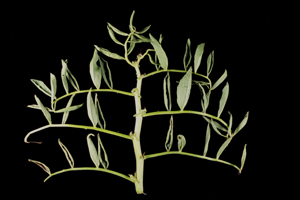Bean leafroll virus
Bean leafroll virus (BLRV)
Host plants
In addition to field bean(Vicia faba), bean leafroll virus occurs on numerous other plant species in the legume family (Fabaceae), with symptoms of damage varying by plant species:
- Alfalfa(Medicago sativa): plants usually show no symptoms.
- pea(Pisum sativum): chlorotic, downward curled leaves
- White clover(Trifolium repens): yellowish, curled leaves
- Common bean(Phaseolus vulgaris): yellowish discolored leaves
- Chickpea(Cicer arietinum): yellowish discolored leaves
- cowpea(Vigna unguiculata): yellowish discolored leaves
- Lentil(Lens culinaris): yellowish discolored leaves
Propagation and transmission
The virus is transmitted by several aphid species, with the pea aphid(Acyrthosiphon pisum) as the main vector. The viruses are transmitted persistently by the aphids, i.e. these are only taken up by the vectors after a longer sucking period, remain infectious in the insect body for a long time and can only be transmitted to healthy plants after a certain period of time. These viruses are mechanically difficult or impossible to transmit. From overwintering legumes, mainly red clover, white clover and alfalfa, aphids can also transmit the virus to distant field bean stands.
Prevention and control
- Early sowings are much less at risk.
- Do not cultivate field beans in the vicinity of overwintering legumes.
- Control of aphids can cause a significant reduction in damage (see list of plant protection products approved in Austria).
Last updated: 22.10.2024
automatically translated
